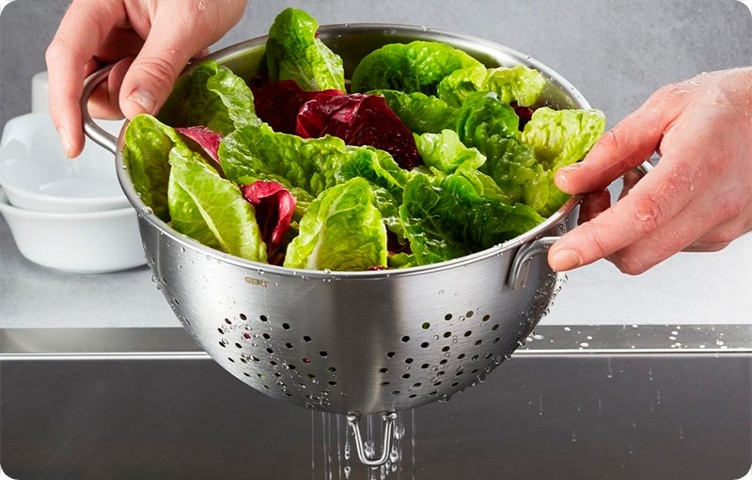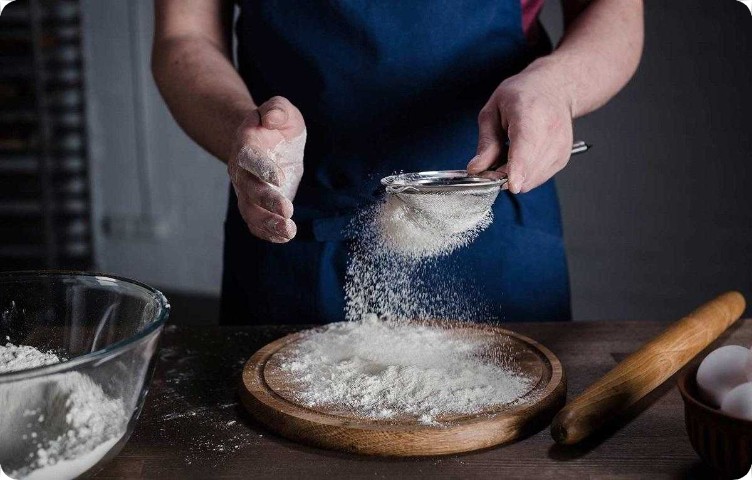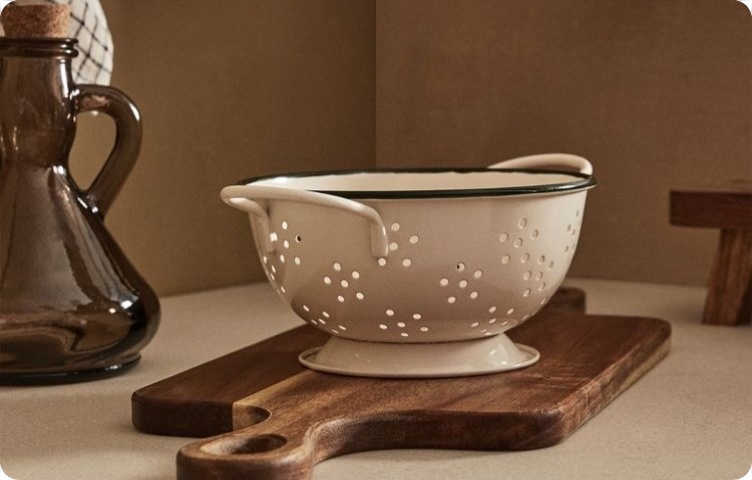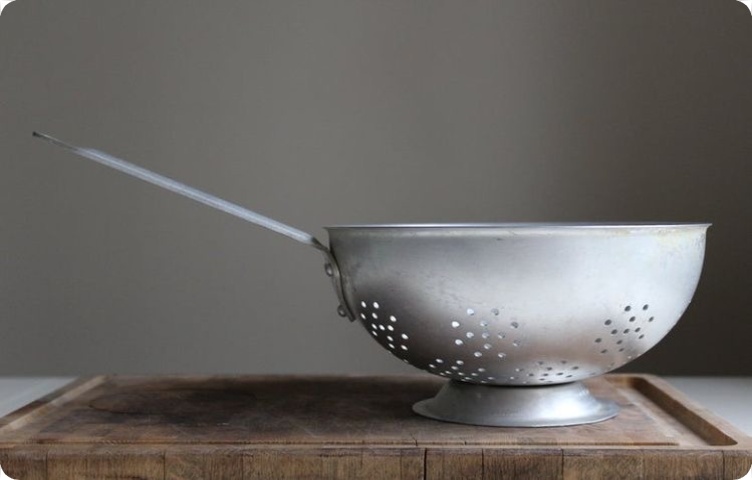Wash the berries, drain the water from boiled pasta or potatoes - simple steps, but how difficult it is to do them without a colander ! That's why a fun vessel with a holey bottom is a must-have in every kitchen. In stores you can find dozens of types of these utensils - metal , plastic , silicone. Find out how to choose the most convenient and practical option!
What is a colander and what is it for?
The name of utensils with a perforated bottom comes from the German word “durchschlagen”, which translates as “holey”. The product consists of a deep bowl, the lower part of which is covered with many holes. It is equipped with one or two handles, and can also have a base with legs.
The main purpose of this dish is to strain boiled foods such as large pasta, potatoes, as well as rinsing raw fruits and leafy vegetables.

A model with a stand can be used to store washed products that are sensitive to moisture - mushrooms, berries, grapes. Keeping them in a colander allows the moisture to evaporate faster, preventing mold.
A ladle with a perforated bottom perfectly replaces a double boiler . Just put the vegetables in it and place it on a pan of boiling water. When frying scrambled eggs or cutlets, the product can be used instead of a frying pan lid.
It is important to distinguish a colander from another perforated utensil - a sieve . If the bottom is made of fine mesh, you have a sieve in front of you, which is used to sift flour or strain liquids. Despite their external similarity, these two items cannot replace each other.

Sizes and shapes
Cooks know dozens of options for perforated utensils, differing in properties and purpose. Let's look at the main five types:
classic - equipped with a round deep bowl with a diameter of 15-25 cm. Holds up to 1.5 liters of liquid. Made in the form of a ladle or bowl with a high bottom and two handles;
conical - Chinese model, also known as chinois. It is distinguished by a cone-shaped bowl and oblong holes. Average diameter - 18-22 cm;
mini colander - has a diameter of 8 to 20 cm, depth - 4-6 cm. Used for washing and drying fruits, small vegetables, and berries.
folding - made from elastic materials, such as silicone. When folded, it resembles a plate;
double - consists of two containers with different types of perforation, nested one inside the other. Serves for thoroughly washing leafy vegetables, herbs, and boiled rice. The parts of the kit can be used separately.
Restaurants use professional perforated tableware with a diameter of over 30 cm.
Types of material
Colanders must be able to withstand temperature changes and not succumb to corrosion. Therefore, they are made from heat-resistant, durable materials - metals, ceramics, plastic and silicone.
Metal
The most common metal for making kitchen utensils is aluminum . Products made from it are lightweight, resistant to corrosion, and can be easily washed with conventional means . You can steam vegetables in an aluminum colander, as the metal can withstand high temperatures well. But foods containing acids, such as berries, can cause aluminum to darken.
Perforated dishes are also made from copper. Such utensils look aesthetically pleasing, withstand temperature changes well, and do not rust. Since copper has the property of killing microbes, it is useful to store freshly washed mushrooms and prepare homemade yogurt in a colander made of this metal. But when in contact with acids, copper dishes darken, so you cannot wash sour berries or sorrel in them.
Silicone
The main advantages of this material are flexibility . Thanks to this, the silicone kitchen accessory can be folded, which saves space in the kitchen . All you need to clean is hot water and a cloth. Silicone cookware does not absorb foreign odors and is resistant to corrosion and acids.
But when using silicone utensils, you need to be carefulthree objects - they can pierce thin walls. Although silicone can withstand temperatures up to + 200° C, it is not recommended to use it for steaming.

Plastic
Durable plastic is a great option if you need an inexpensive colander. Plastic dishes are resistant to impacts and scratches, do not heat up like metal products, and do not corrode . It is important that the packaging indicates that the plastic can withstand temperatures of at least + 100° C. Such utensils can be used for draining hot liquids, but they are not suitable for steaming. A significant disadvantage of plastic is its ability to absorb unpleasant odors.
Ceramic
Ceramic and porcelain are used to create colanders with elegant designs. They resemble bowls with feet or perforated baskets. Ceramic utensils are used for washing and storing berries and fruits, as well as serving them on the table. Perforations help dry food quickly and prevent rotting.
Ceramic colanders are easy to clean and can withstand temperatures up to +500° C. But they are rarely used in everyday life, as they are easily damaged by impacts.

Stainless steel for universal use
Utensils made from this material are suitable for most culinary tasks - draining liquids, steaming, drying washed foods. Stainless steel is durable, resistant to shock and temperature changes. The material is not damaged when in contact with water and acids, and retains a beautiful shine even after prolonged use.
The only maintenance requirement is not to wash stainless steel items with abrasive products, as they will scratch the surface.
Enameled steel
A common version of a colander is a product made of carbon steel coated with a layer of fire-resistant enamel. This type of cookware is compatible with all types of products, including dairy products. The enamel is not destroyed at high temperatures, up to +150° C, and does not rust. Enameled utensils retain their aesthetic appearance for a long time. But when struck, chips form on it, as a result of which the inner steel layer oxidizes and becomes hazardous to health.
Which colander is better?
The best option for home cooking is cookware made of aluminum or stainless steel. They are strong, durable and suitable for most food products. If you often cook pasta, rice, or boiled potatoes, it is better to choose utensils in the form of a ladle with large holes.
For a small-sized kitchen, a folding model made of silicone, which does not take up much space, is more suitable.

How to use a colander correctly?
The order of application depends on the temperature of the dish. If you need to drain pasta and other hot foods, preheat a colander . It is enough to place it on top of the pan in which the food is cooked for 2-3 minutes.
Place the perforated ladle in the sink, at least 10 cm from the edge. Do not try to drain boiling water while holding the equipment suspended - this can cause you to scald yourself with hot steam and turn the dish into an ugly mess. Pour out the boiled food and wait until the water has completely drained. Then transfer the food back to the pan or serve directly onto plates.
To remove liquid from canned beans or fruit, pour the contents of the jar into a colander placed in the sink, shake several times and, if necessary, rinse with water. If you want to save the syrup from the jar, place a perforated dish on top of a larger bowl and empty the jar.
To remove excess moisture from a soft cheese such as ricotta, line the bottom of a colander with cheesecloth and set it over a bowl. Place the cheese on top and leave until all the liquid has drained.
Criterias of choice
The main factor you need to rely on is your culinary preferences. For lovers of pasta and dumplings, it is more convenient to use deep utensils with a large diameter - 20-25 cm. To steam vegetables, you need a small model with a depth of 8-10 cm.
Here are four more criteria that are important to consider when purchasing:
shape - a product with a round bowl is considered universal. But in stores you can find square and conical options, as well as perforated scoops. They are used only in the preparation of certain dishes, and may not find use in a regular kitchen;
materiall - the more often you use the product, the stronger it should be. For everyday use, stainless steel kitchen utensils are recommended;
size of holes - take into account that small holes filter better, but are difficult to rinse;
design - give preference to functional utensils with a high base or non-slip handles. If you steam frequently, look for a model that attaches to the edge of the pan.
For those who know how and love to cook, several perforated vessels of different sizes will be useful, for example, classic, miniature and folding.
Tips for use
At first glance, perforated dishes do not get very dirty. This makes it tempting to simply rinse the product with water after use. But this is not enough - even if the dirt is not noticeable, food particles stick to the holes, especially in plastic and silicone utensils. The starch from the pasta and rice creates a sticky film on the surface.
If the instructions allow, wash the colander in the dishwasher. A good alternative is hand washing with soap and a bottle brush, which works great for cleaning the perforated bottom. Allow the dishes to dry completely before storing them.
Dark stains can be removed with a water-vinegar solution. Make a 3:1 mixture of warm water and white vinegar and use a soft microfiber cloth to remove stains. Then rinse the product with clean water.
















































/https%3A%2F%2Fcomplexbar.com%2Fimages%2Fblog%2F58%2Fdurshlag_glavn-751x480.jpg)
/https%3A%2F%2Fcomplexbar.com%2Fimages%2Fblog%2F245%2Fskov_glavn.jpeg)
/https%3A%2F%2Fcomplexbar.com%2Fimages%2Fblog%2F245%2Fhaiboli.jpg)
/https%3A%2F%2Fcomplexbar.com%2Fimages%2Fblog%2F245%2Fvilki-na-stole-752x480.jpeg)
/https%3A%2F%2Fcomplexbar.com%2Fimages%2Fblog%2F246%2F2024-04-09_17.22.54.jpg)
/https%3A%2F%2Fcomplexbar.com%2Fimages%2Fblog%2F246%2F2024-04-09_17.22.47.jpg)
/https%3A%2F%2Fcomplexbar.com%2Fimages%2Fblog%2F246%2FCODE_anons_foamydrops_752%D1%85480_eng.jpg)
/https%3A%2F%2Fcomplexbar.com%2Fimages%2Fblog%2F246%2FAlina_752%D1%85480_eng.jpg)
/https%3A%2F%2Fcomplexbar.com%2Fimages%2Fblog%2F246%2F2024-04-09_17.23.22.jpg)
/https%3A%2F%2Fcomplexbar.com%2Fimages%2Fblog%2F246%2F2024-04-09_17.23.28.jpg)
/https%3A%2F%2Fcomplexbar.com%2Fimages%2Fblog%2F246%2F2024-04-09_17.23.35.jpg)
/https%3A%2F%2Fcomplexbar.com%2Fimages%2Fblog%2F246%2Fdrinksome_752%D1%85480_eng.jpg)
/https%3A%2F%2Fcomplexbar.com%2Fimages%2Fblog%2F246%2Fnude_752%D1%85480_eng.jpg)
/https%3A%2F%2Fcomplexbar.com%2Fimages%2Fblog%2F246%2F752%D1%85480_eng__1_.jpg)
/https%3A%2F%2Fcomplexbar.com%2Fimages%2Fblog%2F246%2F752%D1%85480_eng.jpg)
/https%3A%2F%2Fcomplexbar.com%2Fimages%2Fblog%2F246%2FStudioRaw_752%D1%85480_eng.jpg)
/https%3A%2F%2Fcomplexbar.com%2Fimages%2Fblog%2F246%2FDoppio_tea_752%D1%85480_eng.jpg)
/https%3A%2F%2Fcomplexbar.com%2Fimages%2Fblog%2F246%2FTognana_Stars_Stripes_752%D1%85480_eng.jpg)
/https%3A%2F%2Fcomplexbar.com%2Fimages%2Fblog%2F246%2FRona_752%D1%85480_eng.jpg)
/https%3A%2F%2Fcomplexbar.com%2Fimages%2Fblog%2F246%2FDoppio_vending_752%D1%85480_eng.jpg)
/https%3A%2F%2Fcomplexbar.com%2Fimages%2Fblog%2F246%2FEssence_sukhie_smesi_752%D1%85480_eng.jpg)
/https%3A%2F%2Fcomplexbar.com%2Fimages%2Fblog%2F246%2FODK_sukhie_smesi752%D1%85480_eng.jpg)
/https%3A%2F%2Fcomplexbar.com%2Fimages%2Fblog%2F246%2Funiforma-barmena.jpg)
/https%3A%2F%2Fcomplexbar.com%2Fimages%2Fblog%2F246%2Fkak-nanyat-barmena.jpg)
/https%3A%2F%2Fcomplexbar.com%2Fimages%2Fblog%2F246%2Fsirop_scale_2400.jpeg)
/https%3A%2F%2Fcomplexbar.com%2Fimages%2Fblog%2F246%2FPeugeot_Anons_Paris_U%27Select_Line_Daman_752%D1%85480_eng.jpg)
/https%3A%2F%2Fcomplexbar.com%2Fimages%2Fblog%2F246%2Fkofe-vostochniy.jpg)
/https%3A%2F%2Fcomplexbar.com%2Fimages%2Fblog%2F246%2FMadler.jpg)
/https%3A%2F%2Fcomplexbar.com%2Fimages%2Fblog%2F246%2Fprofbartender_glavn.jpeg)